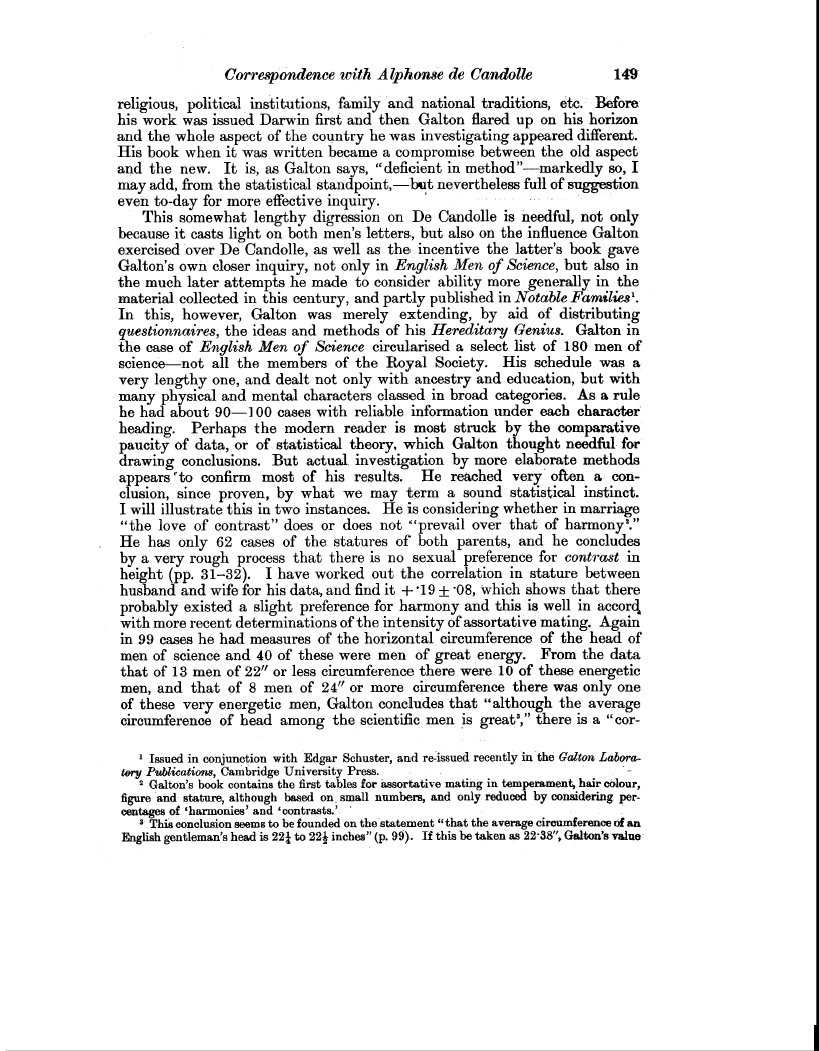Correspondence with Alphonse de Candolle 149
religious, political institutions, family and national traditions, etc. Before his work was issued Darwin first and then Galton flared up on his horizon and the whole aspect of the country he was investigating appeared different. His book when it was written became a compromise between the old aspect and the new. It is, as Galton says, "deficient in method"-markedly so, I may add, from the statistical standpoint,-but nevertheless full of suggestion even to-day for more effective inquiry.
This somewhat lengthy digression on De Candolle is needful, not only because it casts light on both men's letters, but also on the influence Galton exercised over De Candolle, as well as the incentive the latter's book gave Galton's own closer inquiry, not only in English Men of Science, but also in the much later attempts he made to consider ability more generally in the material collected in this century, and partly published in Notable Familiesl. In this, however, Galton was merely extending, by aid of distributing questionnaires, the ideas and methods of his Hereditary Genius. Galton in the case of English Men of Science circularised a select list of 180 men of science-not all the members of the Royal Society. His schedule was a very lengthy one, and dealt not only with ancestry and education, but with many physical and mental characters classed in broad categories. As a rule he had about 90-100 cases with reliable information under each character heading. Perhaps the modern reader is most struck by the comparative paucity of data, or of statistical theory, which Galton thought needful for drawing conclusions. But actual. investigation by more elaborate methods appears 'to confirm most of his results. He reached very' often a conclusion, since proven, by what we may term a sound statistical instinct. I will illustrate this in two instances. He is considering whether in marriage "the love of contrast" does or does not "prevail over that of harmony'." He has only 62 cases of the statures of both parents, and he concludes by a very rough process that there is no sexual preference for contrast in height (pp. 31-32). I have worked out the correlation in stature between husband and wife for his data, and find it +'19 ±'08, which shows that there probably existed a slight preference for harmony and this is well in accord, with more recent determinations of the intensity of assortative mating. Again in 99 cases he had measures of the horizontal circumference of the head of men of science and 40 of these were men of great energy. From the data that of 13 men of 22" or less circumference there were 10 of these energetic men, and that of 8 men of 24" or more circumference there was only one of these very energetic men, Galton concludes that "although the average circumference of head among the scientific men is great'," there is a "cor
' Issued in conjunction with Edgar Schuster, and re-issued recently in the Galton Laboratory Publications, Cambridge University Press.
2 Galton's book contains the first tables for assortative mating in temperament, hair colour, figure and stature, although based on, small numbers, and only reduced by considering percentages of 'harmonies' and 'contrasts.'
s This conclusion seems to be founded on the statement "that the average circumference of an English gentleman's head is 22} to 22J inches" (p. 99). If this be taken as 22.38". Galton's value-

